Seeed Studio XIAO SAMD21 入门指南

Seeed Studio XIAO SAMD21,曾被称为 Seeeduino XIAO,是 Seeed Studio XIAO 系列的首次亮相,这是一系列功能强大的拇指大小开发板,兼容 Arduino。它搭载了强大的 ATSAMD21G18A-MU,这是一款低功耗微控制器。另一方面,这块小板在处理性能方面表现出色,但功耗更低。它采用小巧的设计,可用于可穿戴设备和小型项目。
Seeed Studio XIAO SAMD21 有 14 个引脚,通过引脚复用可用作 11 个数字接口、11 个模拟接口、10 个 PWM 接口(d1-d10)、1 个 DAC 输出引脚 D0、1 个 SWD 焊盘接口、1 个 I2C 接口、1 个 SPI 接口、1 个 UART 接口、串行通信指示器(T/R)、闪烁灯(L)。LED(电源、L、RX、TX)的颜色分别为绿色、黄色、蓝色和蓝色。此外,Seeed Studio XIAO SAMD21 具有 Type-C 接口,可以供电和下载代码。有两个复位按钮,您可以短接它们来复位板子。
文档
关于 Seeed Studio XIAO SAMD21 的使用有两个文档,它们专注于不同的领域,请参考下表:
| Seeed 官方文档 | Nanase 文档 |
|---|---|
| 引脚图 | 接口 |
| Seeed Studio XIAO SAMD21 入门指南 | Seeed Studio XIAO SAMD21 与 MicroSD 卡(SPI) |
| Seeed Studio XIAO SAMD21 GPIO 使用 | Seeed Studio XIAO SAMD21 与 GPS(UART) |
| Seeed Studio XIAO SAMD21 资源 | 单周期 IOBUS |
Seeed Studio XIAO SAMD21 上的 CircuitPython
特性
- 强大的 CPU:ARM® Cortex®-M0+ 32 位 48MHz 微控制器(SAMD21G18),具有 256KB Flash、32KB SRAM。
- 灵活兼容性:兼容 Arduino IDE。
- 简易项目操作:面包板友好。
- 小尺寸:拇指大小(21x17.8mm),适用于可穿戴设备和小型项目。
- 多种开发接口:11 个数字/模拟引脚、10 个 PWM 引脚、1 个 DAC 输出、1 个 SWD 焊盘接口、1 个 I2C 接口、1 个 UART 接口、1 个 SPI 接口。
规格
| 项目 | 值 |
|---|---|
| CPU | ARM Cortex-M0+ CPU(SAMD21G18),运行频率高达 48MHz |
| Flash 存储器 | 256KB |
| SRAM | 32KB |
| 数字 I/O 引脚 | 11 |
| 模拟 I/O 引脚 | 11 |
| I2C 接口 | 1 |
| SPI 接口 | 1 |
| QTouch | 7(A0、A1、A6、A7、A8、A9、A10) |
| UART 接口 | 1 |
| 电源供应和下载接口 | Type-C |
| 电源 | 3.3V/5V DC |
| 尺寸 | 21×17.8×3.5mm |
硬件概述
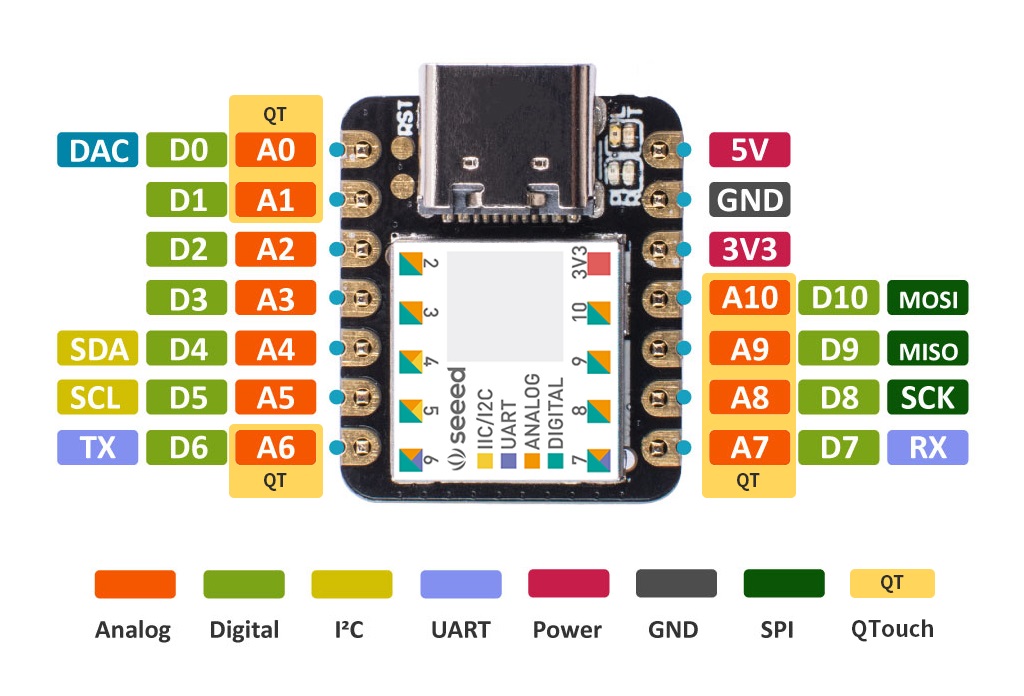



对于通用 I/O 引脚: MCU 的工作电压为 3.3V。连接到通用 I/O 引脚的电压输入如果高于 3.3V 可能会导致芯片损坏。
对于电源供应引脚: 内置的 DC-DC 转换器电路能够将 5V 电压转换为 3.3V,允许通过 VIN 引脚和 5V 引脚使用 5V 电源为设备供电。
重要的是要理解,XIAO SAMD21 背面的 VIN 和 GND 焊盘并非设计用于直接连接电池,特别是不能连接可充电锂电池(LiPo/Li-Ion)。该板缺乏安全操作所需的基本电池管理电路。这些焊盘只是一个替代电源输入点,绕过了板载的保护二极管。如果您希望使用电池为项目供电,您必须使用专用的外部电池管理模块来提供充电和保护功能,然后将该模块的稳压输出连接到 XIAO 的 5V 或 3V3 引脚。
请注意使用,不要撬开屏蔽罩。
进入 Bootloader 模式
有时当用户编程过程失败时,Seeed Studio XIAO SAMD21 端口可能会消失。我们可以通过以下操作解决这个问题:
- 将 Seeed Studio XIAO SAMD21 连接到您的计算机。
- 使用镊子或短线将图中的 RST 引脚短接两次。
- 橙色 LED 灯闪烁并点亮。
此时,芯片进入 Bootloader 模式,烧录端口再次出现。因为 samd21 芯片有两个分区,一个是 Bootloader,另一个是用户程序。产品出厂时会在系统内存中烧录一个 bootloader 代码。我们可以通过执行上述步骤来切换模式。
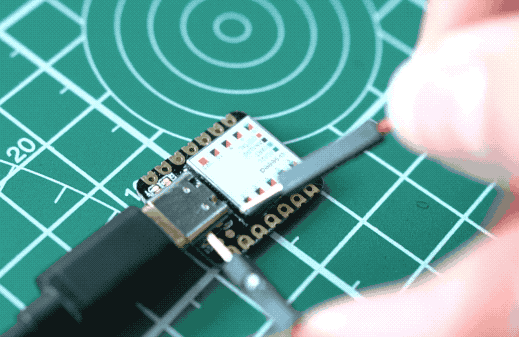
复位
如果您想复位 Seeed Studio XIAO SAMD21,请执行以下步骤:
- 将 Seeed Studio XIAO SAMD21 连接到您的计算机。
- 使用镊子或短线将 RST 引脚短接仅一次
- 橙色 LED 灯闪烁并点亮。
请注意:内置 LED 的行为与 Arduino 上的相反。在 Seeed Studio XIAO SAMD21 上,引脚必须拉低,而在其他微控制器上必须拉高。
中断
Seeed Studio XIAO SAMD21 上的所有引脚都支持中断,但有两个引脚不能同时使用:5 号引脚和 7 号引脚。有关中断的更多详细信息,请查看这里。
引脚复用
我们不需要自己配置引脚,使用引脚后,您可以直接调用函数。
数字输入和输出
- 使用引脚 6 作为数字引脚:
const int buttonPin = 6; // the number of the pushbutton pin
const int ledPin = 13; // the number of the LED pin
int buttonState = 0; // variable for reading the pushbutton status
void setup() {
// initialize the LED pin as an output:
pinMode(ledPin, OUTPUT);
// initialize the pushbutton pin as an input:
pinMode(buttonPin, INPUT);
}
void loop() {
// read the state of the pushbutton value:
buttonState = digitalRead(buttonPin);
// check if the pushbutton is pressed. If it is, the buttonState is HIGH:
if (buttonState == HIGH) {
// turn LED on:
digitalWrite(ledPin, HIGH);
} else {
// turn LED off:
digitalWrite(ledPin, LOW);
}
}
模拟读取
- 使用引脚 6 作为模拟引脚:
void setup() {
// declare the ledPin as an OUTPUT:
pinMode(ledPin, OUTPUT);
}
void loop() {
// read the value from the sensor:
sensorValue = analogRead(sensorPin);
// turn the ledPin on
digitalWrite(ledPin, HIGH);
// stop the program for <sensorValue> milliseconds:
delay(sensorValue);
// turn the ledPin off:
digitalWrite(ledPin, LOW);
// stop the program for for <sensorValue> milliseconds:
delay(sensorValue);
}
串口
- 使用引脚 6 作为 UART 的 TX 引脚(UART 的 RX 引脚是引脚 7):
void setup() {
Serial1.begin(115200);
while (!Serial);
}
void loop() {
Serial1.println("Hello,World");
delay(1000);
}
I2C
- 使用引脚 5 作为 IIC 的 SCL 引脚(IIC 的 SDA 引脚是引脚 4):
// Wire Master Writer
// by Nicholas Zambetti <http://www.zambetti.com>
// Demonstrates use of the Wire library
// Writes data to an I2C/TWI slave device
// Refer to the "Wire Slave Receiver" example for use with this
// Created 29 March 2006
// This example code is in the public domain.
#include <Wire.h>
void setup()
{
Wire.begin(); // join i2c bus (address optional for master)
}
byte x = 0;
void loop()
{
Wire.beginTransmission(4); // transmit to device #4
Wire.write("x is "); // sends five bytes
Wire.write(x); // sends one byte
Wire.endTransmission(); // stop transmitting
x++;
delay(500);
}
SPI
- 使用引脚 8 作为 SPI 的 SCK 引脚(SPI 的 MISO 引脚是引脚 9,MOSI 引脚是引脚 10):
#include <SPI.h>
const int CS = 7;
void setup (void) {
digitalWrite(CS, HIGH); // disable Slave Select
SPI.begin ();
SPI.setClockDivider(SPI_CLOCK_DIV8);//divide the clock by 8
}
void loop (void) {
char c;
digitalWrite(CS, LOW); // enable Slave Select
// send test string
for (const char * p = "Hello, world!\r" ; c = *p; p++) {
SPI.transfer (c);
}
digitalWrite(CS, HIGH); // disable Slave Select
delay(2000);
}
QTouch
关于如何使用 QTouch,我们提供了一个示例项目:如何在 Seeed Studio XIAO SAMD21 的 Q-Touch 功能上制作水果钢琴。
模拟输入和输出
虽然它仍然具有基于 PWM 的"模拟输出",但 SAMD21 还具有数模转换器(DAC)形式的真正模拟输出。该模块可以产生 0 到 3.3V 之间的模拟电压。它可以用来产生更自然声音的音频,或作为一种"数字电位器"来控制模拟设备。
DAC 仅在 Arduino 引脚 A0 上可用,并使用 analogWrite(A0, <value>) 进行控制。DAC 可以设置为 10 位分辨率(确保在设置中调用 analogWriteResolution(10)),这意味着 0 到 1023 之间的值将把电压设置在 0 到 3.3V 之间的某个位置。
除了 DAC 之外,SAMD21 的 ADC 通道也与 ATmega328 不同:它们配备了高达 12 位的分辨率。这意味着模拟输入值可以在 0-4095 范围内,代表 0 到 3.3V 之间的电压。要在 12 位模式下使用 ADC,请确保在设置中调用 analogReadResolution(12)。
串行绘制 DAC
这是一个演示 DAC 和 ADC 的示例。要设置实验,请将 A0 连接到 A1——我们将用模拟电压驱动 A0,然后用 A1 读取它。这是我们在教程中使用过的最简单的电路:

Seeed Studio XIAO SAMD21 使用 Seeed Studio XIAO SAMD21 扩展板
此代码在 A0 上产生正弦波输出,值范围从 0 到 3.3V。然后它使用 A1 将该输出读入其 ADC,并将其转换为 0 到 3.3V 之间的电压。
当然,您可以打开串行监视器来查看电压值流。但如果正弦波通过文本难以可视化,请查看 Arduino 的新串行绘图器,方法是转到 Tools > Serial Plotter。
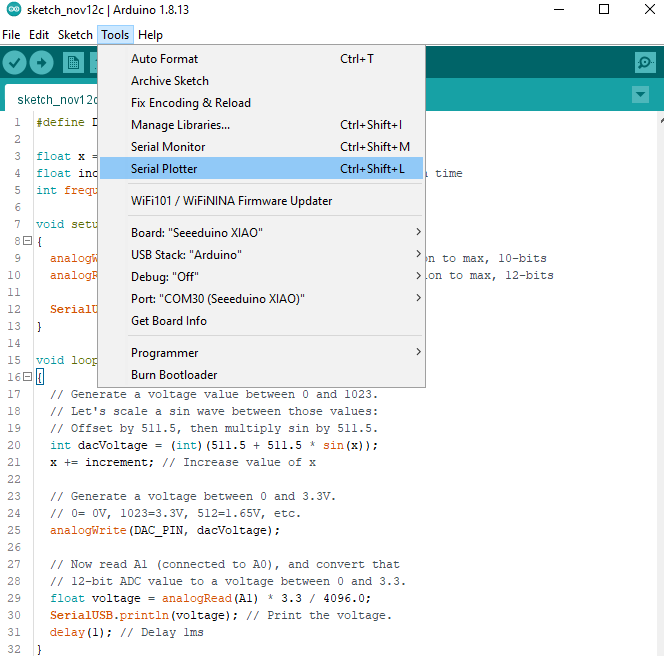
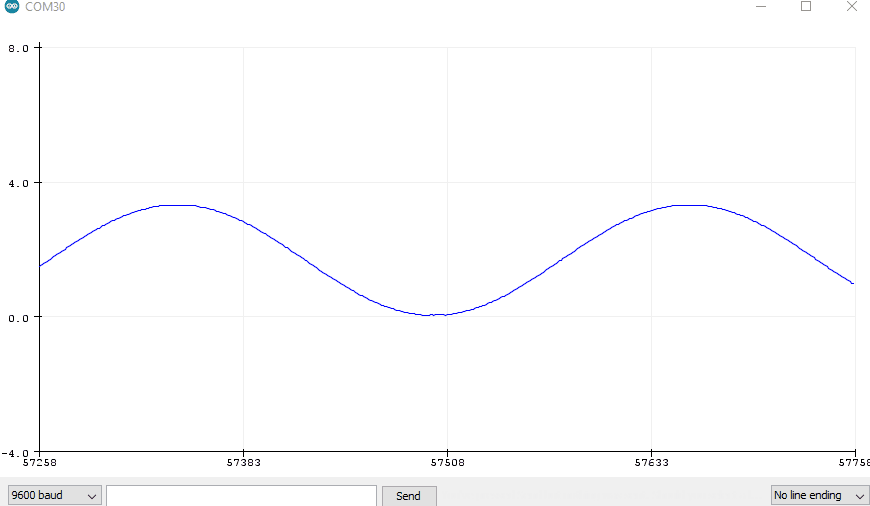
DAC
感谢 Aleksei Tertychnyi 提交代码,所有相关功能都是由他开发和贡献的。
#define DAC_PIN A0 // Make code a bit more legible
float x = 0; // Value to take the sin of
float increment = 0.02; // Value to increment x by each time
int frequency = 440; // Frequency of sine wave
void setup()
{
analogWriteResolution(10); // Set analog out resolution to max, 10-bits
analogReadResolution(12); // Set analog input resolution to max, 12-bits
Serial.begin(9600);
}
void loop()
{
// Generate a voltage value between 0 and 1023.
// Let's scale a sin wave between those values:
// Offset by 511.5, then multiply sin by 511.5.
int dacVoltage = (int)(511.5 + 511.5 * sin(x));
x += increment; // Increase value of x
// Generate a voltage between 0 and 3.3V.
// 0= 0V, 1023=3.3V, 512=1.65V, etc.
analogWrite(DAC_PIN, dacVoltage);
// Now read A1 (connected to A0), and convert that
// 12-bit ADC value to a voltage between 0 and 3.3.
float voltage = analogRead(A1) * 3.3 / 4096.0;
Serial.println(voltage); // Print the voltage.
delay(1); // Delay 1ms
}
结果

入门指南
硬件
所需材料
- Seeed Studio XIAO SAMD21 x1
- 计算机 x1
- USB Type-C 数据线 x1
某些 USB 数据线只能供电而无法传输数据。如果您没有 USB 数据线或不知道您的 USB 数据线是否可以传输数据,您可以查看 seeed USB Type-C 支持 USB 3.1。
-
步骤 1. 准备一个 Seeed Studio XIAO SAMD21 和一根 Type-C 数据线。
-
步骤 2. 将 Seeed Studio XIAO SAMD21 连接到您的计算机。然后黄色电源 LED 应该亮起。
软件
如果这是您第一次使用 Arduino,我们强烈建议您参考 Arduino 入门指南
- 步骤 1. 您需要安装 Arduino 软件。
启动 Arduino 应用程序
双击您之前下载的 Arduino 应用程序(arduino.exe)。
如果 Arduino 软件以不同语言加载,您可以在首选项对话框中更改它。详情请参见 Arduino 软件(IDE)页面。
- 步骤 2. 打开 Blink 示例
打开 LED 闪烁示例代码:File > Examples >01.Basics > Blink。
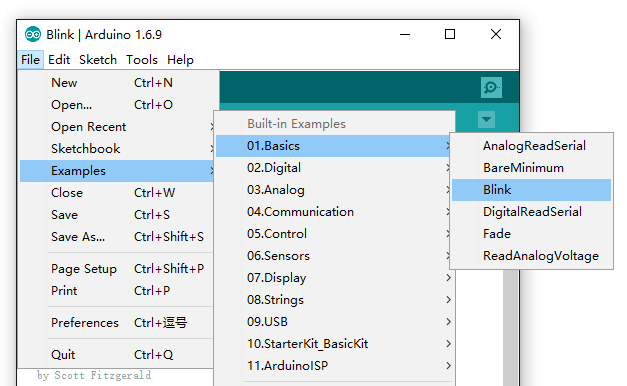
- 步骤 3. 将 Seeeduino 添加到您的 Arduino IDE
点击 File > Preference,并在 Additional Boards Manager URLs 中填入以下网址:
https://files.seeedstudio.com/arduino/package_seeeduino_boards_index.json
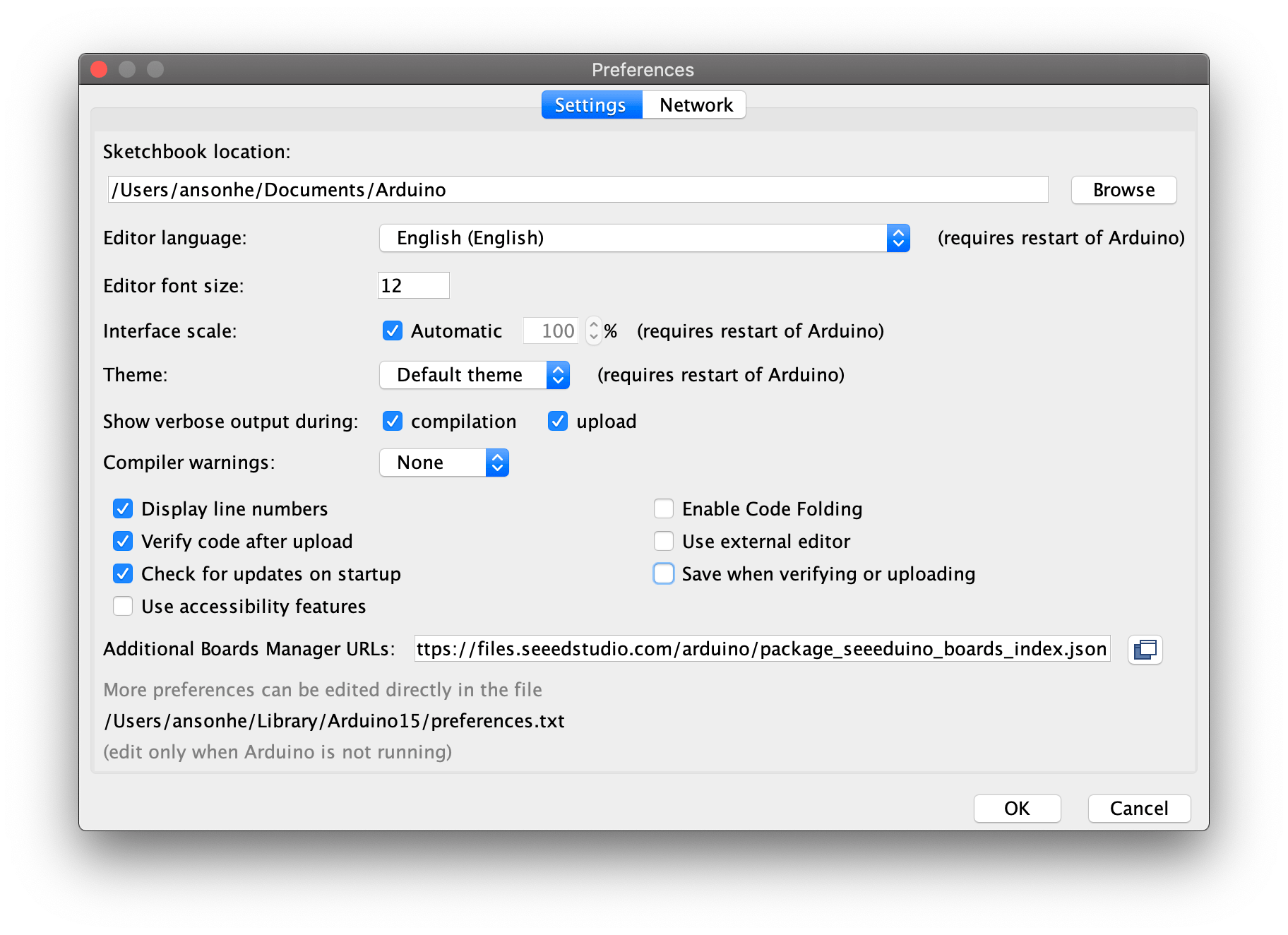
点击 Tools-> Board-> Boards Manager...,在搜索框中输入关键词 "Seeed Studio XIAO SAMD21"。这里会出现 "Seeed SAMD Boards"。安装它。

- 步骤 4. 选择您的开发板和端口
安装开发板后,点击 Tools-> Board,找到 "Seeed Studio XIAO" 并选择它。现在您已经为 Arduino IDE 设置好了 Seeed Studio XIAO SAMD21 开发板。

从 Tools | Serial Port 菜单中选择 Arduino 开发板的串行设备。这很可能是 COM3 或更高(COM1 和 COM2 通常保留给硬件串行端口)。要找出来,您可以断开 Arduino 开发板的连接并重新打开菜单;消失的条目应该就是 Arduino 开发板。重新连接开发板并选择该串行端口。

- 步骤 5. 上传程序
现在,只需点击环境中的 "Upload" 按钮。等待几秒钟,如果上传成功,状态栏中将出现 "Done uploading." 消息。

上传完成几秒钟后,您应该看到开发板上的引脚 13 (L) LED 开始闪烁(橙色)。如果是这样,恭喜!您已经成功运行了 Arduino。如果遇到问题,请参阅故障排除建议。
闪存的最大大小为 8KB,更多信息请参见资源中的 ATSAMD218A-MU 数据手册
示例应用
-
如何使用树莓派修复损坏的 XIAO。感谢 John_Doe 的分享。
资源
-
[PDF] ATSAMD218A-MU 数据手册
-
🔗 [Kicad] Seeed Studio XIAO SAMD21 封装库
课程资源

技术支持与产品讨论
感谢您选择我们的产品!我们在这里为您提供不同的支持,以确保您使用我们产品的体验尽可能顺畅。我们提供多种沟通渠道,以满足不同的偏好和需求。